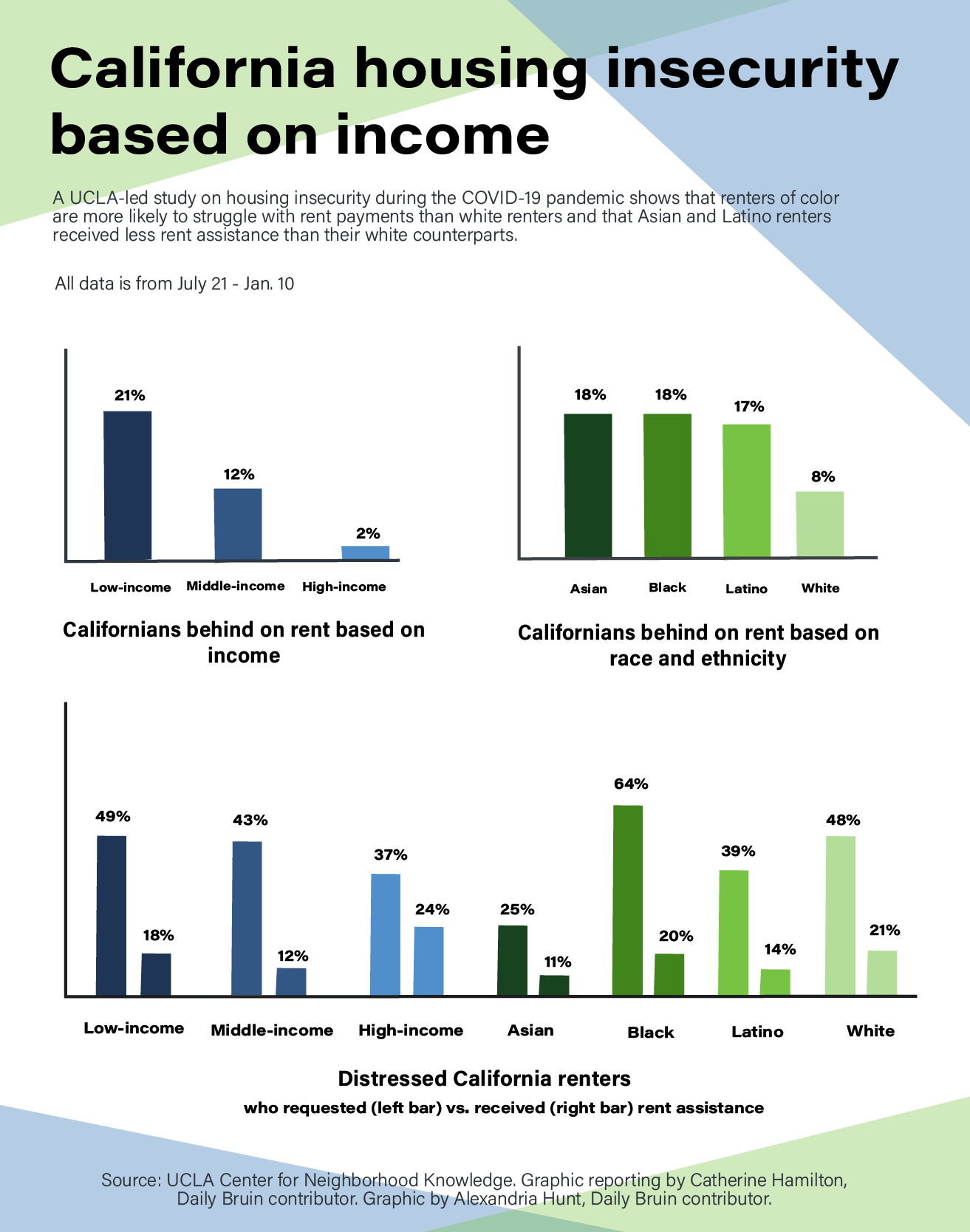Study finds less relief given to Asian American, Latino renters during pandemic


By Phoebe Brous
May 22, 2022 7:45 p.m.
This post was updated May 30 at 10:57 p.m.
Asian American and Latino renters in California were substantially underrepresented among households that applied for and received rent assistance throughout the COVID-19 pandemic, according to a UCLA study.
In a collaboration between the UCLA Center for Neighborhood Knowledge, Chicano Studies Research Center, Asian American Studies Center, and Latino Policy and Politics Initiative, the study found the pandemic worsened California’s chronic housing inequalities for low-income families and households of color, according to the brief released in April.
Paula Nazario, a policy fellow at UCLA’s Latino Policy and Politics Initiative and a co-author of the report, said the study determined that 15% of California renters experienced housing-related stress during the pandemic, adding that low-income renters and renters of color were more likely to struggle with paying rent.
Low-income Asian American and Latino renters were severely underrepresented among those applying for and receiving rent relief, according to the study. In California, 48% of distressed white renters applied for rent relief, while 25% of distressed Asian American renters and 39% of distressed Latino renters applied. Of those that applied, 21% of distressed white renters received rent relief while 11% of distressed Asian American renters and 14% of distressed Latino renters received rent relief, according to the brief.
California’s COVID-19 Rent Relief program provides up to 18 months of assistance on rent and utility bills, according to its website. Silvia González, the director of research at the Latino Policy and Politics Initiative, said although federal dollars funded the Emergency Rental Assistance Program, some cities decided to opt out of the state’s program and run their own programs.
“If you are someone who is experiencing distress, you don’t really know where to go,” González said.
Renters might not know if they qualify for a state- or city-level program, which makes the process convoluted, she added.
Long waiting periods, language barriers, long applications and digital barriers, such as poor internet connection, can also deter people from applying and receiving rental assistance, Nazario said. Additionally, high levels of immigration within the Latino and Asian American communities can discourage individuals from applying for rent relief out of fear that it might affect their legal status, González said.
California implemented the federal Emergency Rental Assistance Program in March 2021, but many eligible renters failed to apply before the March 2022 deadline because the program was adopted late in the pandemic, González said.
González said collaboration on the report started at the beginning of the pandemic after Paul Ong, the director for the UCLA Center of Neighborhood Knowledge, discovered significant disparities in his analysis of housing across various indicators for the Asian American and Latino communities.
Nazario said the research team used the United States Census Bureau’s Household Pulse Survey to analyze California renters’ experiences in successfully applying for and receiving rent assistance during the COVID-19 pandemic.
The Household Pulse Survey tracks disruptions in employment, spending patterns, food security, housing, health and education related to the COVID-19 pandemic, Nazario said. The researchers used racial and ethnic information from the survey to create demographic and income categories to identify those behind on rent and those who received rent assistance, she added.
José Loya, an assistant professor of urban planning and a faculty associate in the Chicano Studies Research Center, said that because of high demand and low supply, California housing affordability has decreased over the past five decades across all income levels. Mass unemployment from the COVID-19 pandemic put an additional strain on low-income households because the decrease in income created higher stress in paying for housing, Loya said.
The brief also provides multiple policy recommendations to combat the disparities in housing insecurity and rental relief as well as the difficulties surrounding the rent relief application process.
The report suggests that California extend the Emergency Rental Assistance Program until all racial and ethnic unemployment rates fall below pre-pandemic rates to ensure eligible renters can receive rental assistance, Nazario said. She added that the researchers proposed that California should extend emergency financial safety net programs to prevent utility shut-offs, forgive debt for people behind on rent and provide security for families and children.
The brief also recommended the state design and implement outreach programs and partnerships with trusted community-based organizations to assist in the application process, she added.
As the pandemic continues to affect households, the researchers plan to perform a follow-up study during the next academic year and are working with state agencies to obtain more individual-based renter data, Nazario said.
“We had the eviction moratorium and an influx of rental assistance, but it’s unclear whether or not those policy interventions had a lasting impact,” Loya said. “I think the evidence is starting to show that it didn’t have a long-term impact on the rental market to alleviate those concerns for low-income families.”

